The Difference Between Dia de los Muertos and Halloween
It is easy to see where the confusion comes from. Halloween coincidentally, is just the day before (31st October), and there are not so many festivities that incorporate the dead so explicitly. But, once you know the difference you’ll see it’s just that — a coincidence. Halloween has an emphasis on scares, candy and mischief making — not to mention getting wasted (for the 18+!) Whereas, Dia de los Muertos is a deeply spiritual and meaningful event for those who celebrate it.
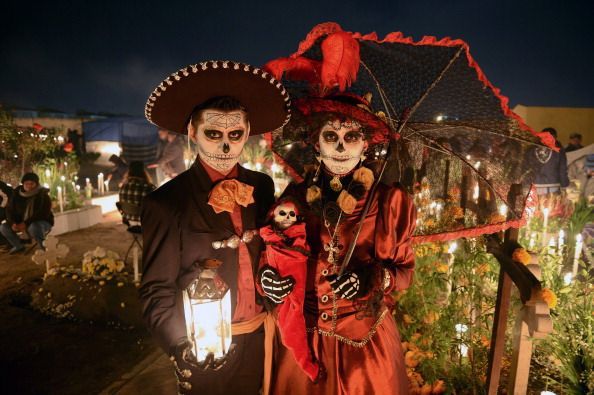
It is all about honoring the dead, rather than running screaming from them (yep, we mean YOU, Halloween!)
Its roots can be traced back several thousand years to the Aztec, Toltec and Nahua people. They believed that the dead of their communities would be offended by sadness and mourning at their passing. Rather, celebrations must be had to keep their spirit alive — the more colourful and joyous the better. Mary J. Andrade, who has written multiple books on the Dia de los Muertos traditions explains;
“People are really dead when you forget about them, and if you think about them, they are alive in your mind, they are alive in your heart.”
How Dia de los Muertos Began
The ancient Aztecs, in today’s central Mexico, understood that death was just another stage of the continuous cycle of existence. Another chapter, spin of the wheel — certainly not the end. In fact, more a beginning. They would present offerings to the goddess Mictecacihuatl (Lady of The Dead) for the departed children and adults. The Aztecs, lovers of a good skull, would incorporate these into all decoration and insignia, representing both death and resurrection. Here very clearly, the seeds of the celebration were planted.
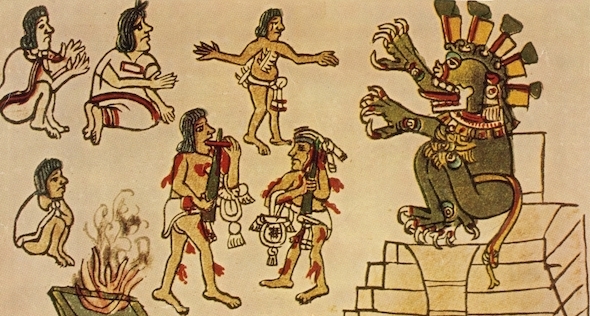
When the Spanish conquered the Aztecs in the 16th century, they copy-pasted their Catholic holidays — in this case All Saint’s Day and All Souls Day — over the indigenous celebrations that they found sacrilegious. However, what resulted was a mish-mash of the former idigneous celebration and the new Catholic practices of ritual and a belief in the afterlife. There are some key components and symbols of Dia de los Muertos celebrations that you must know. These include:
Altars
The centrepiece of the celebration is the altar (or ofrenda), which are built in homes and cemeteries. However, this altar is not for worshipping at. Rather, it is to attract and welcome the spirits back to the living realm. This means that the altar is laden with drinks and food, such as ‘pan de muerto’ (or ‘Bread of the Dead’) and other treats, to revitalise them after their long journey. Photos of the deceased and objects they left behind are also laid in pride of place. A candle is lit for each returning spirit. The gathered burn copal incense, an ancient recipe of tree resin, and sweet smelling marigolds are strewn about to further call their lost family members back. They then sit by the altar sharing stories, poems and jokes about the deceased, and feeling their spirit nearby.
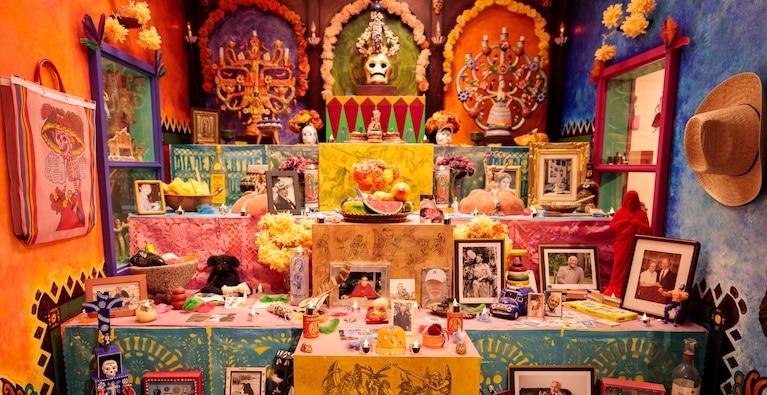
Dia de los Angelitos/ (Día de los Inocentes)
Dia de los Muertos is a two day festival, and each day has a slightly different focus. The first day, November 1st, is also known as Dia de los Angelitos, or ‘Day of the Little Angels’. It is specifically associated with honouring the souls of deceased children. It is said that the children’s day falls before the celebration for deceased adults (Nov 2nd), because — overexcited — they run past their elders, helter-skelter, to arrive a day earlier. Altars for children usually contain extra candy, balloons and toys compared to adult ones.
Calaveras
The calaveros (Spanish for skull) is ubiquitous at Dia de los Muertos celebrations. Whether made of paper mache, sugar or clay, they are brightly coloured and almost psychedelically patterned.
The Calavera Catrina is one of the most famous skeleton figures, a female calavera in a fancy early 20th century European style dress. She was first drawn by printmaker Jose Guadalupe Posada, to comment on Mexicans who were abandoning their indigenous cultures. In 1947 when the Mexican painter Diego Rivera included a Catrina in his mural to celebrate the end of the Mexican Revolutionary War, she became iconic. Today a Catrina is one of the most common calaveras to dress as for Dia de los Muertos parades.
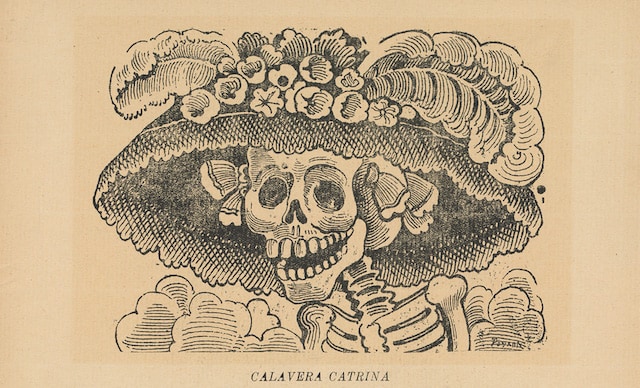
The sugar skull or calaveras de azúcar is another key skele-tastic symbol of Dia de los Muertos. Molded out of sugar, hot water and lemon, these became popular hundreds of years ago. They were another import from the Spanish, who objected to the Aztecs using real bones on altars. They are given as gifts to both the dead and the living, often inscribed with the receiver’s name. More recently, people have begun to paint their faces as if they were sugar skulls. The colours chosen hold special significance too. Red represents blood, orange represents the sun, yellow represents the Mexican marigold (which represents death) purple represents pain, white and pink are purity and hope, and black signifies the Land of the Dead.
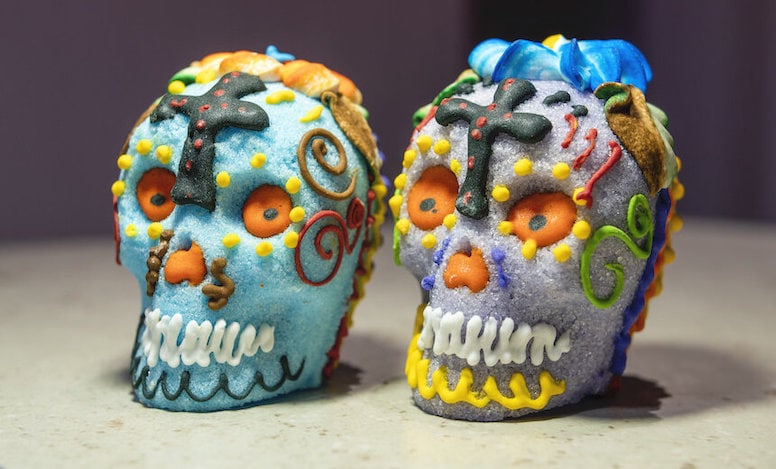
Visiting Graves of the Deceased
In preparation for the celebrations, families visit the graveyard and tidy, clean and decorate the graves of their loved ones. On the 2nd night (Nov 2nd) they will take food and drink to the graves to entice the spirits and hang out with other families visiting their loved ones. In this way it becomes a big party of ancestors, living and dead!
Parades
A recent addition, and mainly taking place in Mexico City, the large-scale Dia de los Muertos parades are an example of American culture creeping in. Cos they love a parade — Halloween, Thanksgiving, St Patrick’s Day — you get the gist.
On the day of the parade many Catrina’s descend in elaborate make-up for a bright, colourful parade. Strangely, this parade is not actually traditional. Although there have always been colourful processions between graves and alters with lights and music, this large scale parade is actually an example of life imitating art. James Bond’s 2015 outing, Spectre features a chase scene through a fictional Dia de los Muertos parade in Mexico City. So beguiled were the movie viewers, that the Mexico City tourist board actually started putting on the parade for real! Although some people see this as ‘selling out’ or pandering to tourists rather than respecting tradition, others see it as a natural extension of what the festival already was. Alejandra González Anaya, one of the creative directors of the parade explains;
“As a result of the James Bond film we have decided to take advantage of the spotlight and put on the streets a great offering which we give to our dead. I think it’s an opportunity for all Mexicans to show the world what the tradition is made of.”
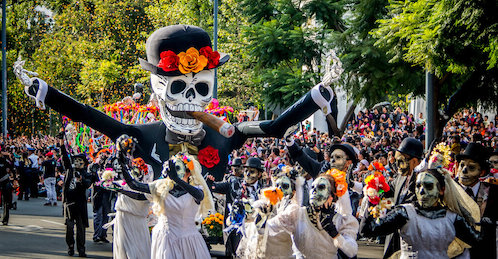
Although cancelled last year due to the covid-19 pandemic this year the parade will return in all its glory.
Why The Festival Continues To Grow In Popularity
Interest in the Dia de los Muertos festival continues to grow across the world, building year on year. Sure, it just so happens to be infinitely Instagrammable, and films like Coco (2017) and Spectre (2015) have helped to make it global, but it is clear there is something else at play here too. Most modern cultures have a very sterilised and negative relationship to death. Funerals are occasions of black shrouded mourning, and graveyards are not considered a particularly pleasant place to be. Although normalised, this isn’t a healthy attitude to death, which really is a part of life. In fact it’s the only inevitability in this crazy ol’ thing we call existence. As Nobel Prize winning writer Octavio Paz wrote in his famous work Labyrinth of Solitude;
“The Mexican … is familiar with death, jokes about it, caresses it, sleeps with it, celebrates it. True, there is as much fear in his attitude as in that of others, but at least death is not hidden away: he looks at it face to face, with impatience, disdain or irony.”

What We Can Learn From Dia de los Muertos
For many people, the discovery of a festival that encourages us to contemplate, embrace, celebrate, and swim in life and death, is both exciting and reassuring. A new and more joyful way of looking forward and back, that means our loved ones can stay with us. It’s no wonder that non-Mexican and non-Latinx people are grasping this festival as a new perspective. However, this is where difficulties relating to appropriation and the confusion of traditions can occur. The most important thing is to be informed and do your research if you are interested in Dia de los Muertos celebrations, and are not a member of these communities. As long as you know your stuff and respect tradition, even some ‘sugar-skull’ face paint might not be out of the question. Mexican-American make-up artists Andrea Ortega Costigan and Mariana McGrath reassures us that;
“Even if you’re not Mexican, we say go ahead and do that sugar-skull makeup for your costume party… all we ask is that you understand the meaning behind it, you take a little slice of the Mexican way, and you remember the people in your life who have passed on to the next.”
Dia de los Muertos – A Psychedelic Connection?
Another famous tradition of the indigenous peoples of Latin America is that of the use of psychedelic plants (or entheogens). Maria Sabina, the first curandera to share the secret of magic mushrooms with Westerners was from Oaxaca, Mexico, a region with strong spiritual Dia de los Muertos tradition. During the sacred mushroom ceremonies (Veladas) participants experience ‘ego death’ and interact with ‘spirits’. Perhaps these traditions helped feed into the way in which this culture are able to embrace, rather than fear, death. If spiritual death and rebirth are possible, and connection with spirits desired rather than feared, the circle of life feels closer, more tangible. We are more likely to fear what we cannot see, or do not try to understand.
In accordance, why not take a psychedelic trip in honour of Dia de los Muertos? If the true spirit of the holiday is to connect deeply with ancestors, your spirituality, and focus on rebirth, then it could be the perfect fit.
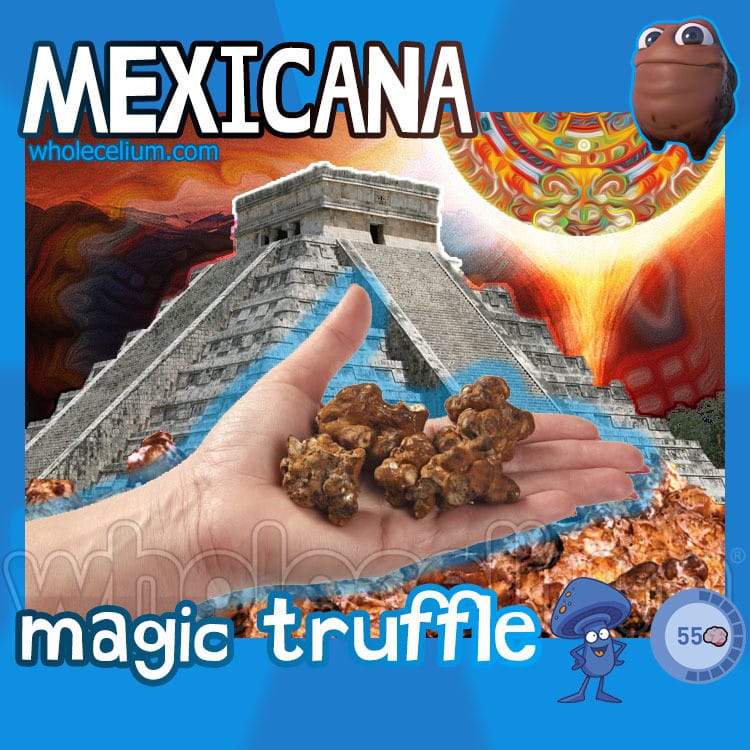
And, we have THE magic truffle for this very occasion — our Psilocybe mexicana! Set up a cosy space, some lights, and get tripping. Find your own way, inspired by the fantastical celebrations of Dia de los Muertos, to connect with spirits this season.





